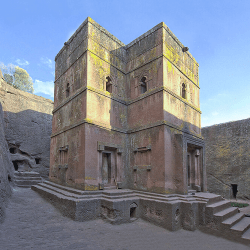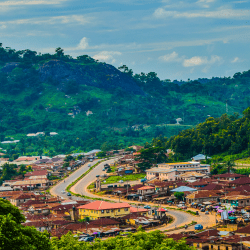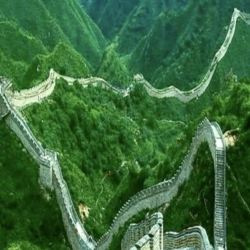UNESCO World Heritage Sites in China are:
- Imperial Palaces of the Ming and Qing Dynasties in Beijing and Shenyang
- Mausoleum of the First Qin Emperor
- Mogao Caves
- Mount Taishan
- Peking Man Site at Zhoukoudian
- The Great Wall
- Mount Huangshan
- Huanglong Scenic and Historic Interest Area
- Jiuzhaigou Valley Scenic and Historic Interest Area
- Wulingyuan Scenic and Historic Interest Area
- Ancient Building Complex in the Wudang Mountains
- Historic Ensemble of the Potala Palace, Lhasa
- Mountain Resort and its Outlying Temples, Chengde
- Temple and Cemetery of Confucius and the Kong Family Mansion in Qufu
- Lushan National Park
- Mount Emei Scenic Area, including Leshan Giant Buddha Scenic Area
- Ancient City of Ping Yao
- Classical Gardens of Suzhou
- Old Town of Lijiang
- Summer Palace, an Imperial Garden in Beijing
- Temple of Heaven: an Imperial Sacrificial Altar in Beijing
- Dazu Rock Carvings
- Mount Wuyi
- Ancient Villages in Southern Anhui – Xidi and Hongcun
- Imperial Tombs of the Ming and Qing Dynasties
- Longmen Grottoes
- Mount Qingcheng and the Dujiangyan Irrigation System
- Yungang Grottoes
- Three Parallel Rivers of Yunnan Protected Areas
- Capital Cities and Tombs of the Ancient Koguryo Kingdom
- Historic Centre of Macao
- Sichuan Giant Panda Sanctuaries – Wolong, Mt Siguniang and Jiajin Mountains
- Yin Xu
- Kaiping Diaolou and Villages
- South China Karst
- Fujian Tulou
- Mount Sanqingshan National Park
- Mount Wutai
- China Danxia
- Historic Monuments of Dengfeng in “The Centre of Heaven and Earth”
- West Lake Cultural Landscape of Hangzhou
- Chengjiang Fossil Site
- Site of Xanadu
- Cultural Landscape of Honghe Hani Rice Terraces
- Xinjiang Tianshan
- Silk Roads: the Routes Network of Chang’an-Tianshan Corridor
- The Grand Canal
- Tusi Sites
- Hubei Shennongjia
- Zuojiang Huashan Rock Art Cultural Landscape
- Kulangsu, a Historic International Settlement
- Qinghai Hoh Xil
- Fanjingshan
- Archaeological Ruins of Liangzhu City
- Migratory Bird Sanctuaries along the Coast of Yellow Sea-Bohai Gulf of China (Phase I)
- Quanzhou: Emporium of the World in Song-Yuan China
- Cultural Landscape of Old Tea Forests of the Jingmai Mountain in Pu’er
> View other UNESCO World Heritage Sites
More on World Heritage Sites
UNESCO (United Nations Educational, Scientific and Cultural Organization) World Heritage Sites comprise 1,199 properties.

World heritage property is a legacy from the past, that people live with today, and pass on to future generations.

The cultural and natural heritage are both irreplaceable sources of knowledge and inspiration.





UNESCO seeks to encourage the identification, protection and preservation of cultural and natural heritage around the world that are considered to be of outstanding value to humanity. This is embodied in an international treaty known as the Convention concerning the Protection of the World Cultural and Natural Heritage, adopted by UNESCO in 1972.
A World Heritage Site is an area or landmark designated by UNESCO for having cultural, historical, scientific or other forms of significance. The sites have legal protection by an international convention.
A World Heritage Site is nominated by their host country and determined by the international committee to be a unique landmark which is geographically and historically identifiable and having a special cultural or physical significance. World Heritage Sites are usually ones with ancient features, historical structures, buildings, cities, deserts, forests, islands, lakes, monuments or mountains.
The site may signify a remarkable accomplishment of people and serve as evidence of intellectual history or a place of unparralled natural beauty.
The sites are intended for practical conservation for posterity, which otherwise would be subject to risk from human or animal trespassing, unmonitored, uncontrolled or unrestricted access, or threat from local administrative negligence. Sites are demarcated by UNESCO as protected zones.
The programme catalogues, names, and conserves sites of outstanding cultural or natural importance.
The work began with the Convention Concerning the Protection of the World’s Cultural and Natural Heritage. The convention was adopted by the General Conference of UNESCO on 16 November 1972. Since then, 195 states have ratified the convention, making it one of the most widely recognised international agreements and a popular cultural programme.










